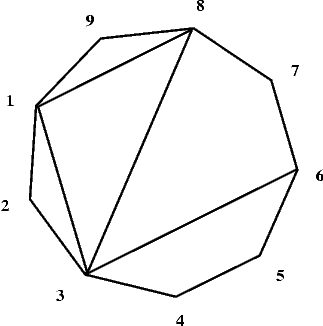
Zadanie Wielokąty (wie)
Pomóż nam usprawnić bazę zadań!
Polygon
Memory limit: 32 MB
We are given a convex polygon  of
of  sides (where
sides (where  ) and
) and  its distinct diagonals not crossing one
another inside the polygon. (The only point that two distinct diagonals may
share is a vertex of the polygon.) Vertices of the polygon are numbered
successively from
its distinct diagonals not crossing one
another inside the polygon. (The only point that two distinct diagonals may
share is a vertex of the polygon.) Vertices of the polygon are numbered
successively from  to
to  counterclockwise. All the
diagonals divide
counterclockwise. All the
diagonals divide  into smaller convex polygons whose interiors do
not
intersect.
into smaller convex polygons whose interiors do
not
intersect.
Example
Four diagonals: 1-8, 8-3, 3-1 and 3-6 divide the polygon  shown in
the
picture below into two quadrilaterals and three triangles.
shown in
the
picture below into two quadrilaterals and three triangles.

Task
Write a program that:
- reads a description of the polygon
 and its diagonals from the
standard input,
and its diagonals from the
standard input, - calculates the maximal number of sides of a polygon among the polygons
created by the division of
 by the given diagonals,
by the given diagonals, - writes the result in the standard output.
Input
In each line of the standard input two positive integers separated by a single space are written.
In the first line there is the number of vertices  of the polygon
and the number of diagonals
of the polygon
and the number of diagonals  .
.
In each of the following  lines there is a description of one
diagonal of the polygon in the form of a pair of positive integers. These
integers are the numbers of the vertices of the polygon the diagonal joins. Just
after the second number there is the end of the line.
lines there is a description of one
diagonal of the polygon in the form of a pair of positive integers. These
integers are the numbers of the vertices of the polygon the diagonal joins. Just
after the second number there is the end of the line.
The data in the standard input are written correctly and your program need not verify that.
Output
In the standard output one should write one positive integer - the maximal
number of sides of a convex polygon created by the division of the given polygon
 .
.
Example
For the input data:
9 4 1 8 8 3 3 1 3 6
the correct result is:
4
Task author: Krzysztof Diks.
Kontakt
In the event of technical difficulties with Szkopuł, please contact us via email at [email protected].
If you would like to talk about tasks, solutions or technical problems, please visit our Discord servers. They are moderated by the community, but members of the support team are also active there.

 English
English